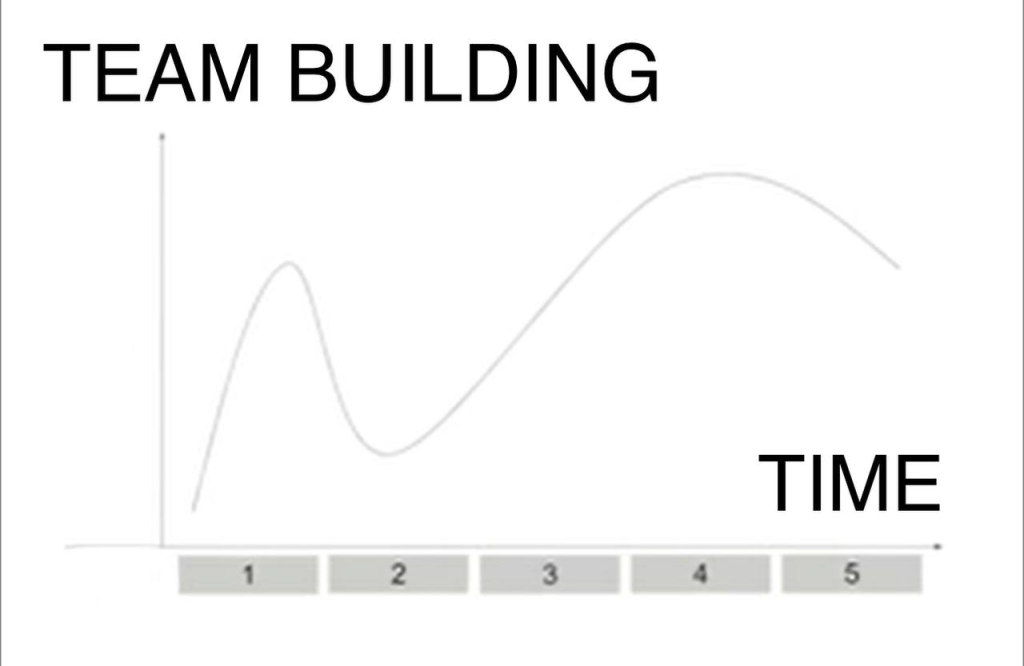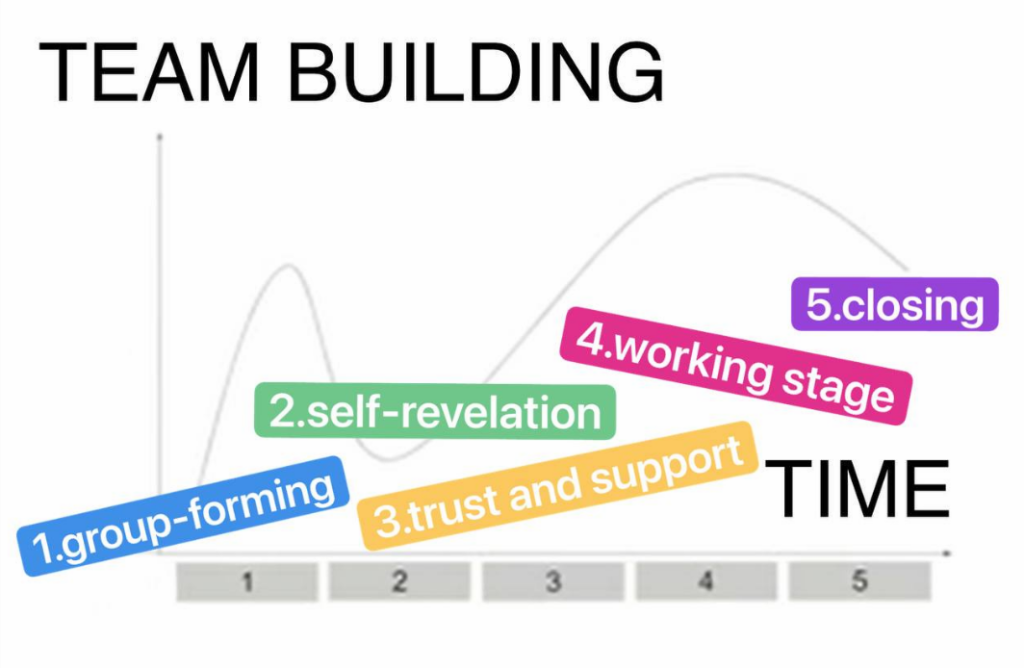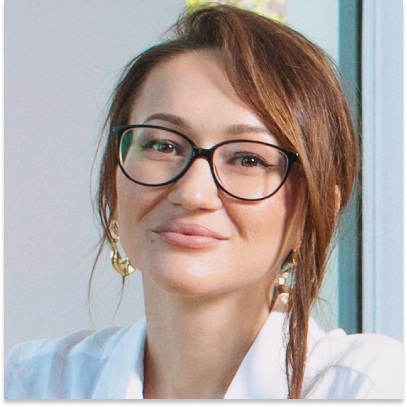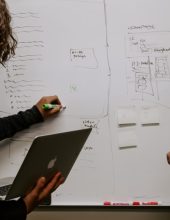How does the team live and which processes are taking place inside it and why? What to do in the team in order to progress and move from one stage of development to another? How does each individual team member develop and is there an ideal vector for self-development in a team?
Stages of a group and team development
As you can see on the scheme there are five stages of team development. The top vector is dedicated to team building, in other words, the energy of the team, and the degree of team performance. The bottom vector is devoted to time: the time of growth of the team or the lifetime of the team, the time of the project the team is working on.
As you can see, the graph is undulating. It means, at first the schedule grows, the level of development and team cohesion increases, and then there is a decline in the second stage. One way or another the recession ends and at the fourth stage, the team reaches the peak of its development. And further, I will tell a little about what each stage means, how a team member feels at each stage, what tasks the team faces, and what are the risks and opportunities at each stage of team development. So, let’s start!
First stage: group-forming
In other words, this is the stage of acquaintanceship. It is also a stage of pseudo-cohesion. This is the stage at which team members get to know each other, the tasks of the team, team values, and so on. The main goal of this stage is to achieve primary cohesion.
That is, it is important for the team members to learn about each other, to understand what is the purpose of their teamwork, to find out what rights, responsibilities, and duties they have in their work, it is important for the team members to understand all the subtleties of their functionality, and so on. At this stage, the main need of the team members is safety.
What does it mean? This means that team members meet with each other, but there is still a lot that is not clear to them. It’s like going into a dark room where you can see only the objects’ outlines and it is not clear what is where, and if there is someone else, and you need time to look around and get used to the darkness. If everything goes well, then the level of team cohesion increases, as we saw on the graph, and the team begins to move towards its goal.
But why is this stage called pseudo-cohesion? It is very important that at this stage the team members feel comfortable and safe, and in the working sense of the word they “fall in love” with their team. So that they really feel the strength of the team and understand how good they are with each other. Here the important guidelines are “we are a team, we are together, and we can do everything together”. This is important because, without that drive and positive vibes, the next challenges the team will face can be hard to overcome.
What is the problem at the first stage? The main problem here is the fear of negative evaluation and rejection by the team. And if this fear is not worked out properly, then the team will not be able to get to the second stage and will not be able to proceed further because the presence of this fear eliminates the initiative, risks, and the possibility of making mistakes. And really, the team leaders or the whole team, in general, should “legalize” the possibility of an error, the feedback rules, and should make it clear that this can and will happen, this is normal, and how further interaction will be carried out after the appearance of any error.
Second stage: self-revelation
At this stage team members already feel safe, and can comfortably communicate and boldly interact with each other. People begin to open up in a new way: someone starts to have their own expectations from teamwork, some initiative appears, the desire to change something, improve or correct work, and so on.
The main task of the team at this stage is to overcome the fears of its members and to develop responsibility for personal changes and the desired changes in the team. What does it mean? This means that the team members should really be ready to take the initiative, feel the peculiarity of their role in the team, and be aware that “the overall result of the team depends on my results of work as well”.
At this stage, as you remember, the level of energy and team cohesion is reduced. This stage is characterized by a high level of confrontation between team members. The main problem is the race for power and status in the group. Leaders are determined, groupings are formed, roles are distributed within the team, leaders and other team members have to withstand significant pressure from group “aggression”.
Naturally, the level of cohesion is reduced. But this is a necessary stage for team development in the future because it is at this moment that a very important thing happens: the members of the team learn how to act in a crisis situation, at the moment of conflict, emotional tension and so on.
The important thing here is the ability to negotiate, to find time for feedback, and to learn how to be really tolerant of each other, it is important to remember the common team result, and that each of the team members is important to achieve this result.
The basic need of team members here – is acceptance. In other words – not in friendship and not in the fact that “we are all blood brothers”, not in the feeling that we will work together until the end of our days.
But in the statement that “I notice my difficulties and I notice yours; I notice that you are very important for the team in one aspect, but you have difficulties or disadvantages in some other functionalities or in other tasks; I notice how I can be useful and how I can let the team down. We see it in each other and speak about it openly, thereby accepting each other with our features, pros and cons, strengths and weaknesses”. At the same time, a sense of security is still quite important.
Here the group determines whether the team is a safe place, clarifies again its goals, and position, and somehow negotiates in a new way already seriously, and consciously, realizing that the first stage was important, but now they have reached a completely different level. And here there are opportunities and skills to act in a moment of crisis, the ability to negotiate when everything doesn’t go according to plan, and the team receiving a stronger charge of self-confidence for further accomplishments.
Third stage: trust and support
The main task of this stage is awareness of one’s own value, and the value of another person in the team, readiness for competition and at the same time readiness for submission if necessary. It is really important to remember that there is a team goal, but there is also a personal one. It is impossible to ignore and deny neither the first nor the second. It is important for team members to realize their own uniqueness, and also to realize the value of other colleagues.
As before, the main need of the team members at this stage is acceptance, but compared to the previous stage of self-revelation, this stage is already less conflictive and at the end of this stage, recognition and self-realization become live issues for the team members.
The main problem of the transition to the fourth stage is whether the ability to work both autonomously and jointly is formed. That is, by the end of the third stage, team members should be able to work not only together, but also separately with their own tasks.
Fourth stage: working
Just by the time of this stage, the team members approach the most developed, ready for interaction, they have already resolved all conflicts, discussed all their responsibilities, and understood all their functionality, they really know each other much better.
It is for this particular stage of the project and the team’s work, that it’s better to plan the most complex, large and responsible tasks. Because at the beginning when the team is just accelerating, there are many crises, there are misunderstandings, and it is better to do something easier there, but at the working stage it is really important to complete the tasks for which everyone has gathered.
In terms of dynamics, the main task of the team is to maintain readiness, and interaction, and contribute to the biggest group and individual results. Returning to the previous stage, we make sure that not only the goal of the team is realized, but there’s also professional growth for each of the members of this team.
As mentioned above, at this stage team members receive the most difficult tasks, solve the most difficult issues, and the main need of team members at this stage is self-realization and recognition of their work and merits. That is, they should notice and feel that they are not just nice people who are comfortable with each other, but that they do really important things that are noticed by other people, and recognized by the team as successful actions, and these employees receive gratitude for their work.
The main problem or difficulty that people face at this stage is frustration, the absence of the desired team result, and the feeling of the impossibility of achieving this result. If this happens, then a crisis naturally occurs: we worked, and we did our tasks, but the result is far from what we planned before.
“What if my actions, my performance, my achievements are not noticed by anyone? I do not receive feedback and do not receive acceptance”. At this point, the crisis may recur and the level of team cohesion will decrease again. It is important not to allow this.
Fifth stage: closing stage
The stage at which the team comes to logical project completion is when the team completes its activities and sums them up. Perhaps the team will continue further, but there is already some intermediate result which is a kind of small completion.
The main task at this stage is to help the team members successfully go through the separation process. What it is? It is the divestment of the team member from the teamwork. That is, if the team ceases to exist, then the person needs to realize what happened, sum up the results, and not be afraid to move on. Because a person may not understand how he actually worked, whether it was useful for the team, what exactly he did, what is his achievement or his difficulty, what his growth area, and what did he become an expert in.
The main problem at this stage is the fear of leaving the group, that is, the team can even drag out the group process to some extent, or sluggishly exist further, because no one can imagine what will happen to them further without this team (We finished one project, but how do we move on? What will happen to us?).
Based on this, the main need of the team members at this stage again becomes safety. But it’s already about summing up the results of personal and teamwork.
A few words of summary
Let’s take another look at the chart that was presented at the beginning of the article. We see that the life of the team proceeds in waves. This cycle can be repeated. Even within the same project, a team can experience several downturns, which can happen due to different circumstances.
This may happen not only because of what was described above, but also because of a change in the working conditions (for example the team moved to another place, it is necessary to negotiate again, and the level of cohesion decreases again. Or, for example, new members came to the team, or some key figures of the team left it).
Individual development chart in the dynamics of teamwork
Let’s remember the basic needs in terms of teamwork, which were indicated in the previous part.
These are the needs:
- security,
- acceptance,
- recognition.
These are the three basic needs that must be met by each team member individually in the process of work. What needs to happen to meet these needs?
Each team member must go through three stages and achieve a result there.
- “I am a member of the team”. Some identity that describes who am I in this team. For example, I am a tester, I have these rights, duties and tasks. Or I am a designer, and I have such duties, responsibilities, work schedule and a goal.
- Formation of the image “You are a member of the team”. That is, I notice who else is next to me, I understand whom I should interact with for what reason, I know some of the personal characteristics of the people around me, I know how to take these characteristics into account in teamwork, I understand how to communicate with them.
- The stage when “I achieved a personal goal, as well as a goal in the area of work that I was entrusted with, which relates to the team goal. And it was done in cooperation with the rest of the team”.
Challenges
As you might expect, each of the above stages has its own challenges.
Misunderstanding
For example, at the first stage, a team member still cannot understand his role, tasks, and responsibilities, and cannot understand how he can fit into the existing team model.
Perhaps this is because the team is rather chaotically built and the functionality is not clearly defined. Or perhaps this team member simply has personal characteristics that increase his level of anxiety and do not allow him to feel comfortable and safe at work, not allow him to feel his competence and understand whether he is suitable for the team.
In the latter case, all the energy of the team member is spent not on achieving the identity “I am part of the team”, but on ensuring its own security, which is not achieving. In such a case, without off-board assistance, a team member can become a background player who is very little present in teamwork, or he can leave the team after a short period of time.
Completely different identity
In the second case the participant may form a completely different identity and may come to the conclusion not “I am a member of the team”, but “I am an imaginary member of the team”. This happens precisely because a person does not care to orient himself and understand how the team works, and what rights and obligations he has.
It’s not that he doesn’t care, he just doesn’t think about it. Such a team member may, for example, see some tasks, grab it, start performing it, not really understand with whom else it is necessary to interact within this task, or not quite understand the criteria for the high-quality result of this task.
Often this happens because team members either do not understand how to negotiate, do not realize the need for it, are too anxious and afraid to ask clarifying questions, cannot establish agreements, or are too focused on their private issues. As if they live their own separate lives, they may look like a little strange team member.
Need for acceptance
Let’s talk about what happens next when the need for acceptance becomes a topical issue for team members. In this case, there are four possible difficulties at the second stage “You are a member of the team”.
Even if a person has formed the identity “I am a team member”, the journey is not over. For example, a person could not, due to some circumstances, see real people in front of him. He imagined that he was working with wonderful people who had no flaws, a man who created his colleagues relying on his own fantasies, and not real facts and communication with them.
Isolation
Often this can be seen if there are two friends working in a team who are together all the time, but in relation to other team members can behave quite apart. On all matters, such friends first consult with each other, share their opinions, and thereby keep the rest of the team in the dark. In such cases, the team usually does not really notice such participants either, because such people are too isolated from others. Such group members form not a real image, but an imaginary one.
Outsider
Let’s consider another option. For example, the participant formed the image “I am a member of the team” as it should. What will he do next?
There are several options here. For example, the team member like the couple from the previous description will find himself a “strange” comrade with whom he will get close, they will seem to be together in a team, but at the same time outside of it. Thus, together they will strengthen the fact that there are outsiders in the team.
Here, for example, can be such a path of development that a team member didn’t agree with anyone at all. He has not reached the stage of recognizing others, and not formed an understanding of other team members’ work and identities, and has not moved to the stage of “You are a member of the team”. This person will continue to perform his tasks, work, but will be separate from himself.
Such a person will have to be constantly regulated because he has not yet learned to understand the evaluation criteria of his work, he has not clearly understood his functionality, he does not communicate particularly with other team members, he does not check with other colleagues regarding the team’s development vector and deadlines, and so on.
Rejection
Or another possible option: «I am a formed member of the team, but at some stage of communication with the team I received a rejection». It is not necessary that this was said directly by another team member, it may be that the person himself felt this feeling of rejection and convinced himself of it.
Naturally, the energy of such a person falls, he goes into apathy, opposition, and the feeling that the team does not need him and is not accepted. In this case, he can either leave the team or remain a background member who performs his local tasks but does not interact much with other team members.
Recognition
And finally, we move on to the third stage of team member development. Now the task of the team member is to achieve their individual goals, the goals set for them in the team, and to come to the final result together with the team. What are the difficulties at this stage?
First of all, those people who are outside the team in terms of communication have difficulties. Those participants who seem to be in their own separate world or in their micro-group, experience great difficulties at the final stage of work on the project. Where it is necessary to receive recognition from team members, these people will not be able to receive it, since they were all the time away, and often there was a miscommunication between them.
Naturally, recognition is either clearly less or is clearly absent compared to other team members. At this point, team members who have always been kept apart from the team may feel demotivated, and frustrated may realize that they are not much recognized by their colleagues and their work results seem not to be so important. Maybe the results of their work are actually quite good, but the team has a little warm attitude towards them, little acceptance and responsiveness.
Such members can either leave the team at the final stages or simply take very little part in the completion stages of a project or some global tasks.
The same can happen to those members of the group with whom everything seemed to be fine at the previous two stages, but suddenly at the last stage they received no recognition from the team, but harsh criticism. At this moment, a person can sharply feel that all his work was in vain.
Of course, he is a team member, he communicates with all team members, but it turned out that he could not prove himself and show his professionalism and efficiency. The energy of such a person falls and he may want to leave the team. Such a person can be returned by giving him a second chance, helping correct mistakes, go through a difficult situation with him, but in practice, the team often does not have enough time and energy for this.
Journey ends
This is where the team journey ends. Just like in group dynamics, another round of the same can happen, when everything starts anew (for example, the team has new tasks), and then the team members go through everything again from the very beginning.
Summary
To sum up the above, I can say this. On any project and in any job, it is important that all team members have the opportunity to feel safe, feel accepted, and receive recognition for their work.
There are some good questions for the whole team:
- Do you have a common goal?
- Can you state this goal right off the bat without looking anywhere?
- Do you accept and share this goal?
These questions help you understand if there are cognitive distortions, if a different understanding of the goal is interfering with your work, or maybe someone is not aware of their contribution to the team’s common cause.
Also, at the stage of realizing yourself as part of a team, it is important to honestly answer yourself questions – is my role in this team clear to me, do I share the goals of the team, discuss with colleagues how I can enrich the team and be useful to achieve the overall result.
Thanks to everyone for taking the time to read this article. And I wish you cool projects and teams that will help you reach your professional potential to the maximum!
***
If you are interested in other articles in the field of teamwork, we recommend (PL): Jak motywować zespół? Perspektywa Scrum Mastera, Inteligencja emocjonalna – wpływ liderów na efektywność zespołów, Czy da się stworzyć idealny zespół projektowy w branży IT?, Wespół w zespół, czyli kilka słów o zespole projektowym i jego formowaniu,


















Leave a comment